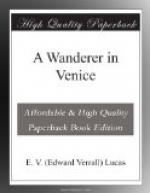Among the smaller beauties of Venice—its cabinet architectural gems, so to speak—S. Maria dei Miracoli comes first. This little church, so small as to be almost a casket, is tucked away among old houses on a canal off the Rio di S. Marina, and it might be visited after SS. Giovanni e Paolo as a contrast to the vastness of that “Patheon de Venise,” as the sacristan likes to call it. S. Maria dei Miracoli, so named from a picture of the Madonna over the altar which has performed many miracles, is a monument to the genius of the Lombardo family: Pietro and his sons having made it, in the fifteenth century, for the Amadi. To call the little church perfect is a natural impulse, although no doubt fault could be found with it: Ruskin, for example, finds some, but try as he will to be cross he cannot avoid conveying an impression of pleasure in it. For you and me, however, it is a joy unalloyed: a jewel of Byzantine Renaissance architecture, made more beautiful by gay and thoughtful detail. It is all of marble, white and coloured, with a massive wooden ceiling enriched and lightened by paint. Venice has nothing else at all like it. Fancy, in this city of aisles and columns and side chapels and wall tombs, a church with no interruptions or impediments whatever. The floor has its chairs (such poor cane-bottomed things too, just waiting for a rich patron to put in something good of rare wood, well carved and possibly a little gilded), and nothing else. The walls are unvexed. At the end is a flight of steps leading to the altar, and that is all, except that there is not an inch of the church which does not bear traces of a loving care. Every piece of the marble carving is worth study—the flowers and foliations, the birds and cupids and dolphins, and not least the saint with a book on the left ambone.
S. Maria Formosa, one of the churches mentioned in the beautiful legend of Bishop Magnus—to be built, you remember, where he saw a white cloud rest—which still has a blue door-curtain, is chiefly famous for a picture by a great Venetian painter who is too little represented in the city—Palma the elder. Palma loved beautiful, opulent women and rich colours, and even when he painted a saint, as he does here—S. Barbara (whose jawbone we saw in the S. Rocco treasury)—he could not much reduce his fine free fancy and therefore he made her more of a commanding queen than a Christian martyr. This church used to be visited every year by the Doge for a service in commemoration of the capture of the brides, of which we heard at S. Pietro in Castello. The campo, once a favourite centre for bull-fights and alfresco plays, has some fine palaces, notably those at No. 5250, the Malipiero, and No. 6125, the red Dona.




